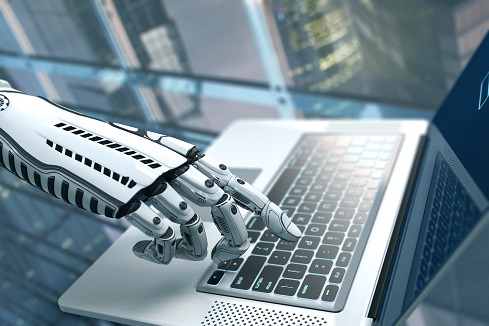
Today’s managers and executives need to oversee humans and machines in this age of AI and RPA, but should machines be managed as humans in a way that some suggest?
As artificial intelligence and robotics process automation (RPA) usage continue to expand in enterprises, managers and executives need to learn how to supervise more than just human employees. They need to manage the human-machine workforce.
Some suggest that intelligent machines should be managed like people. More specifically, they suggest that, like people, virtual employees should have a job title and key performance indicators (KPIs). Others say it’s the combination of humans and machines that needs to be managed.
For example, in some warehouse environments, there are handoffs from semiautonomous robots to people. Since time is money, warehouses must ensure that the handoffs are efficient.
“You could plan the number of tasks that one of these physical robots could be doing in a given timeframe before the people around them can consume the work that’s coming their way,” said Helen Potevin, VP analyst at Gartner. “You need to understand what activities these machines are doing and how people need to interact with that to complete the entire process as efficiently as possible.”
Driving higher ROI from the human-machine workforce
Companies have invested millions of dollars in technology only to be disappointed with the ROI. According to an October 2018 survey of 12,000 people by multinational professional services network PwC, 90% of leaders believe they’re buying technology with employees in mind, but 53% of employees disagree. Further, only half of staff and 64% of managers are satisfied with the learning resources they have at their disposal.
Carrie Duarte, workforce of the future leader at PwC, said some of the questions clients are asking include: If a machine is a member of the workforce, should we put them in our HR system? How can we get our workforce to adopt and adapt to the technology so we can drive more value from our investments? How can we achieve our business and digital strategies and accelerate innovation?
“[W]hatever the business strategy is, whatever the digital strategy is, we’re seeing CEOs and business leaders appreciating that the workforce is either going to be an impediment to achieving that strategy or help us get there better, faster, quicker,” said Duarte. “It’s all about how [can] we make the workforce more productive, more efficient, more comfortable with the amount and pace of change so that they help drive things forward?”
One obstacle almost every organization faces is pushback from a subset of employees. While most of today’s workers aren’t technophobic, some are very concerned about the negative impacts intelligent machines may have on their careers.
Some organizations may have contributed to the fear, uncertainty and doubt by setting automation goals aimed at reducing the workforce by double-digit percentages. While most organizations are taking a more strategic approach to AI and intelligent automation than that today, organizational leaders should be aware of how the company’s goals, culture or policies could contribute to a belief or set of beliefs that serve as obstacles to the business’ future success.
When it comes to adopting technologies such as AI or RPA, leading by example encourages employees to follow suit. Leading by example also helps advance a culture of “we’re all in this together.”
“[It’s important] for an organization to have that culture of caring and to find how and when to be there for the workforce and to encourage people to be there for each other,” said PwC’s Duarte. “That allows the workforce to just relax [and it] helps the workforce navigate this crazy pace of change.”
Gartner shares its longer-term view of human-machine workforce management in a recently-updated 2018 report entitled, Future of Work Scenarios 2035: How Will Leaders Manage in a Majority-Bot Workforce World? While the time horizon of that report exceeds the scope of this article, there are recurring themes common to both this shorter-term view and Gartner’s longer-term view.
Upskilling is important
Companies should be prepared to invest in employee upskilling. Conversely, employees should be willing to invest in their own careers.
The PwC report stated that employees are willing to spend up to two days per month in training to update their digital skills, if the training is offered by their employer.
“A large percentage of the workforce is interested in learning new skills and trying new things, but they’re not encouraged in any way [by their employers] to invest in learning and change the way they work,” said PwC’s Duarte.
One mistake employers make is sending employees to a training class and hoping the brief time spent there will result in new behavior. However, if what’s taught in the classroom isn’t applied, the newly-acquired knowledge fades away quickly. Instead, the new knowledge should be an integral part of an updated work routine.
“[E]ven before you get the technology skills it’s about working openly and socially. That’s a major cultural change in many organizations,” said PwC’s Duarte. “And then how do you show what ‘good’ behaviors look like and reinforce [those] so that they become more commonplace rather than the exception?”
People are adapting by default to some degree, but organizations should proceed by design
Chatbots are everywhere and so is machine learning. Whether people realize it or not, these technologies are altering what people do and how they do it.
For example, in customer and technical support scenarios, a chatbot is often the first line of defense. Within enterprises, helpdesk chatbots are providing answers to common questions that employees in IT or HR used to answer.
“We never really think of [chatbots] as a worker or something that you need to manage,” said Gartner’s Potevin. “It’s just another way of accessing a service and getting things done that’s different than how we used to do it before, but we adapt to it.”
While there is some adaptation to intelligent systems by default, organizations should approach digitalization by design, putting the necessary change management mechanisms in place to help achieve the desired future state faster and with less friction.
Bottom line
Business operations, technology and economic models are evolving so rapidly that the human-machine partnership has become essential. Since the state of that partnership is not static, humans have to adapt to the changes by constantly learning new skills. One of those skills is learning how to manage the human-machine workforce.
While most employees are willing to embrace continuous learning, leaders are wise to lead by example and ensure that employees have the resources and organizational support they need to succeed in an ever more digitalized business environment.
Read more of our articles on emerging areas of technology:
10 Strategic Technology Trends for 2020
Restart Data and AI Momentum This Year
Lisa Morgan is a freelance writer who covers big data and BI for InformationWeek. She has contributed articles, reports, and other types of content to various publications and sites ranging from SD Times to the Economist Intelligent Unit. Frequent areas of coverage include … View Full Bio
More Insights



Leave a Reply